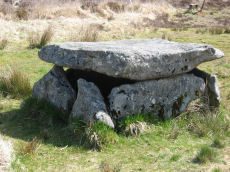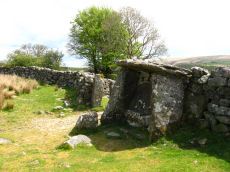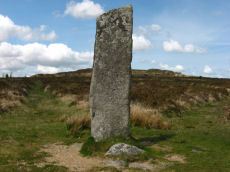
ROUTE: Easy walk. Start Postbridge, over Lakehead Hill and Bellever Tor to Dunnabridge Pound - return to Postbridge via Laughter Tor. Distance 11km.
SITES OF INTEREST: Lakehead Hill - settlements and numerous cists, cairn circles and stones rows. Bellever settlements. Dunnabridge Pound. Laughter Tor - standing stone, stone row and settlements
PUBLIC TRANSPORT: Walk originally based on the discontinued Transmoor Bus Service. Probably now possible starting from Plymouth to Yelverton or starting from Tavistock.
Lakehead Hill and Bellever
This walk is perhaps the easiest and most rewarding for sheer quantity of sites of antiquity. For those who want a shorter walk just walk up Lakehead Hill to Bellever Tor and return!
Start at the bus stop in Postbridge. Walk 200m W along the B3212 to the road on the left to Bellever. The entrance to Bellever Forest is on the junction with the main road. There are 3 main tracks from the entrance to Bellever Forest, the middle one is the most direct route to Lakehead Hill - but can be very muddy. Take the main track on the Left and cut back to the right after around 300m. After a short distance there will be a narrow path to the right which goes south uphill into the clearing on Lakehead Hill. This clearing can be seen clearly on the OS map and also towards the centre of the Google map above. At the very start of this area is a near circular area which includes the Kraps Ring enclosure. Ascending the hill numerous cairn circles and kists can be found with ease. For a full listing see the Lakehead Hill site which has a table reproduced to the right of this page. There are Dartmoor National Park wooden post markers visible by each of these sites which help to locate and identify them.
Walk A: Short route up to Bellever Tor and back
Continue south towards Bellever Tor. On the south slope of Bellever is a Bronze Age enclosure and settlements. It is worth ascending to the top of Bellever Tor for the view. The return journey to Postbridge can be done by coming back along much the same route but choosing a different path back through Bellever forest. There is a path that goes just to the east of Bellever Tor - this has a route that drops down hill for a short distance to connect up with another main route back north through Bellever Forrest. Alternatively you can head east towards the river and the very busy car parking area. There is beautiful scenery around this area but there are no direct paths back to Postbridge from here without following the road.
Walk B: Longer route via Dunnabridge
If you ascend Bellever Tor you can drop down due west to find a cairn on the edge of the tree line on the slopes of Bellever Tor. Follow the tree line south to the Newtake area. Within the Bellever Newtake there are several other cairns and kists although these can be quite difficult to locate due to the rough and overgrown terrain. Some of the cairns are identifiable as raised mounds with rough vegetation. Some reportedly have stone slabs surrounding them but this may be difficult to see. It is difficult to find all of these sites which may indicate that they are not, or no longer are, very substantial. With a wall on your left there is a path that heads due south and curves east to meet the B road near Dunnabridge. Follow the road round to Dunnabridge Pound. Just to the left of the entrance to Dunnabridge Pound is the Judges Chair.
From Dunnabridge Pound head north east towards Laughter Tor. After about 1km is the Laughter Tor double stone row. This stone row is separated into two segments separated by some distance either side of the new take wall. The Laughter Tor sanding stone should be easy to locate. From the stone row either proceed on to Laughter Hole and round to Bellever, the route back from Bellever being mostly by road, or alternatively head north-west back to Bellever Tor and back to Postbridge through one of the paths in the plantation.
Page last updated 22/8/11











